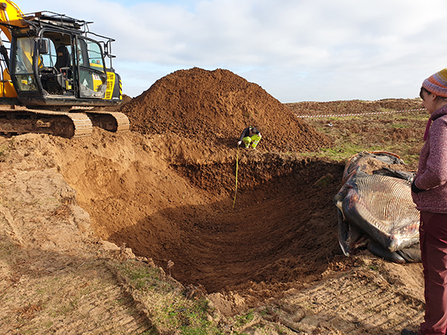On the evening of the 16 December, the warden Sarah and Assistant Warden Cameron returned back to the site to find an anonymous note that a whale had washed up on the beach. Come daylight, Cameron found a Juvenile Minke whale 7.3m (nearly 24’) long. This incredible creature was already deceased when it was washed ashore.
Walney Whale
Andrew Walter
© Andrew Walter
The Minke Whale's tongue inflated during decomposition creating a balloon like appearance.
We reported it to the Cetacean Stranding Investigations Program, based at London’s Natural History Museum. Although they do conduct examinations of whales, in our case decay had already set in, meaning it was too late for a full necropsy.
We weren’t sure what to do next, but luckily for us, our friends at nearby National Trust Sandscale dealt with a similar issue a few years ago and were able to provide us with some excellent advice, including cutting holes in the carcass to prevent the build-up of decomposition gas and an unfortunate explosion.
We then spoke to Natural England and the Borough Council – and no-one seemed clear on what we should do. With South Walney being quite isolated, we considered leaving the Whale on the beach to provide a food source for scavengers, particularly over the winter. Once back from Christmas Break, however, checking the cameras we’d placed to monitor the carcass showed that no animals were showing any interest other than sheep and a rat.
The carcass clearly would need properly disposing of, certainly before the summer when things could get very unpleasant. The Coastguard recommended we talk to Her Majesty’s Receiver of Wreck, as all whales (and sturgeon) washed ashore are correctly termed “Royal Fish” and are the personal property of the Queen..
HM Receiver of Wreck informed us that the Royal Fish must be disposed of legally and safely. It is a criminal offence to hold any part of a cetacean without a licence, so we must dispose of it to prevent people taking parts of it - indeed, by this point most of the baleen had already been cut away by trophy seekers. Our only option was to remove to landfill or bury, and our local landfill did not have the capacity for a whale.

© Sarah Dalrymple
Our grazier had kindly towed the whale up the beach to a location for possible burial; however, South Walney is a SSSI and protected for the high quality of the vegetated shingle beaches and sand dunes. Burying it here would cause significant damage to this fragile habitat.
Our Grazier was called back in, and he towed the carcass up onto the reserve proper, where we have an area of dune restoration; this is where the rough grazing grass has been removed to allow the original sand dunes to move about naturally, and won’t be damaged by being dug up a bit more. A huge hole was dug by a large digger, and the whale finally laid to rest.
Sarah Dalrymple - Reserves Officer and South Walney Warden
